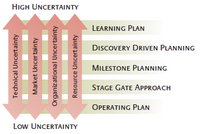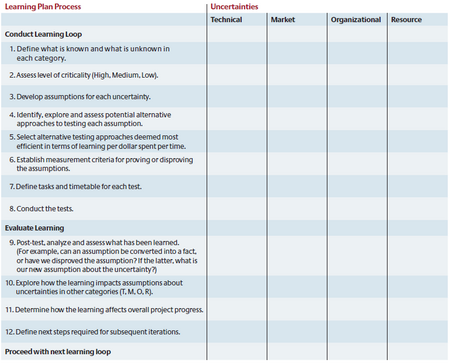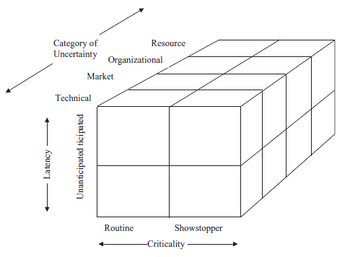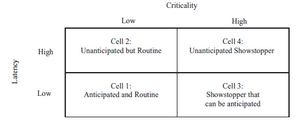Learning plan
| Line 50: | Line 50: | ||
The second dimension of uncertainty, latency, refers to the degree to which an uncertainty can be anticipated. The higher the latency, the more difficult is it to perceive the uncertainty and find appropriate assumptions for it. As a result, high latency uncertainties may not be resolved with assumption testing before they actually occur. The concept of latency is not explicitly noted in the learning plan. Nevertheless, project teams need to try their best in cataloguing also those uncertainties that are difficult to anticipate but might have a large influence on the project's progress. Moreover, they need to be flexible in their learning approach as they might need to adapt to new circumstances as the project matures. | The second dimension of uncertainty, latency, refers to the degree to which an uncertainty can be anticipated. The higher the latency, the more difficult is it to perceive the uncertainty and find appropriate assumptions for it. As a result, high latency uncertainties may not be resolved with assumption testing before they actually occur. The concept of latency is not explicitly noted in the learning plan. Nevertheless, project teams need to try their best in cataloguing also those uncertainties that are difficult to anticipate but might have a large influence on the project's progress. Moreover, they need to be flexible in their learning approach as they might need to adapt to new circumstances as the project matures. | ||
| − | The third dimension of uncertainty refers to the criticality of the uncertainties identified within the four categories. An uncertainty is found to be critical if it is a potential showstopper for the project. In order to ensure a project's success these therefore need to be resolved immediately. The assessment of criticality takes place in the second step of the learning plan process. The most critical uncertainties should be targeted by assumptions and tests | + | The third dimension of uncertainty refers to the criticality of the uncertainties identified within the four categories. An uncertainty is found to be critical if it is a potential showstopper for the project. In order to ensure a project's success these therefore need to be resolved immediately. On the other hand, an uncertainty which is routine does not threaten a project's survival. The assessment of criticality takes place in the second step of the learning plan process. The most critical uncertainties should be targeted by assumptions and tests as soon as possible. |
| + | The dimensions latency and criticality are found to interact with each other as shown in the following figure. | ||
| + | |||
| + | [[File:Latency_Criticality.png|300px|thumb|right|Figure 1: Latency versus Criticality <ref name="Uncertainty"> O'Connor, Gina and Rice, Mark, A Comprehensive Model of Uncertainty Associated with Radical Innovation, Journal of Product Innovation Management, 30(S1), 2013. </ref>.]] | ||
'''The learning plan process''' | '''The learning plan process''' | ||
Revision as of 14:24, 16 February 2021
Contents |
Abstract
[tbd] This article is about the ‘Learning plan’ - a tool to overcome the challenge of making sound decisions while facing uncertainties. It provides a systematic framework to facilitate a learning process that turns un-knowns into knowns. In principle, a learning plan is a document that can be used by a project team to resolve uncertainties in four different categories: market, technical, resource and organizational uncertainty. For the most critical ones the team develops assumptions for their solution. These are then tested and, if disproved, turn into a new assumption or, if proved, into a fact. A learning plan is essential to successful project management in the light of uncertainty. This is especially the case in new product development where the degree of uncertainty is typically high. In detail, learning from experience is one of the principles that reflect successful programmes and projects [1] [2]. An example learning process consists of several learning loops or passes through the learning plan. In each, a set of assumptions get tested until a sufficient level of certainty is reached. Typically, a project team needs about 3-4 learning loops to progress on the project. Each iteration consists of two phases: the testing of critical assumptions and the evaluation. The latter consists of a review of the results where new assumptions and further tests are identified.
Big idea
A learning plan is a tool to overcome the challenge of making sound decisions while facing uncertainties. It provides a systematic framework to facilitate a learning process that systematically turns un-knowns into knowns. It is particularly useful in the project planning stage when a project team needs to manage multidimensional uncertainties. This is especially the case in new product development where the degree of uncertainty is typically high. Therefore, learning from experience is one of the principles that reflect successful projects as they involve a temporary organization that may not already have the necessary experience. Through the learning plan, a project team can systematically gain this experience through experimentation during the life cycle of a project [1] [2].
In short, a learning plan has the following characteristics: [3] - It catalogues uncertainties - It connects uncertainties with assumptions - It prioritizes uncertainties based on their criticality - It presents testing approaches to resolve critical uncertainties - It documents a project’s progress in terms of learning outcomes and consequences thereof
While a learning plan has no universal format, a basic learning plan should consist of at least two sections. In the first section, the participants of the learning process catalogue uncertainties in four categories: market, technical, resource and organizational uncertainty. For the most critical ones the team then develops assumptions that get tested and, if disproved, turn into a new assumption or, if proved, into a fact. In the second section, this is then followed by an evaluation of the learning where results are reviewed and, if necessary, new assumptions and tests are developed to initiate another iteration of the learning plan. The learning plan is therefore continuously revised to adopt learning outcomes.
Background
A common characteristic of projects is that they all face uncertainty in the planning process. As projects mature the project team will gain experience which increases the availability of decision-relevant knowledge while never fully eliminating all un-knowns. Uncertainty can be seen as the cause of individual project risk which is defined as "an uncertain event or condition that, if it occurs, has a positive or negative effect on one or more project objectives". [4]. Reducing uncertainty to make decisions based on knowledge is therefore a common goal in project management. The process of acquiring new, or modifying existing, knowledge, behaviors, skills, values, or preferences based on experience is called learning [3]. Uncertainty as a lack of knowledge or information can therefore be reduced with an appropriate learning process and is also an essential part of risk and uncertainty management procedures [5].
The learning plan as a tool for systematic learning which ideally results in uncertainty reduction. It is widely used for innovation projects, particularly for radical innovations, where the degree of uncertainty is typically higher. In order for project teams to proceed, assumptions have to be made. Over time, learning reduces the number of these assumptions and turns them into new knowledge. This in turn leads to a higher certainty in management decisions while projects mature. [3]
There are different established approaches to cope with project uncertainty. The following figure provides an overview of different project planning approaches each associated with a certain degree of uncertainty where it proved most useful. The learning plan is therefore seen as the project planning framework that can be used in situations of particularly high uncertainty. While the degree of uncertainty ideally gets reduced throughout the lifecycle of a project and several iterations of the learning plan, other project planning approaches may take over. [3]

Application
The following figure shows a template for a basic learning plan. It incorporates both the steps of the learning plan process and the categories of uncertainties that are found to occur in projects. These refer to the multidimensionality of uncertainty. For a successful application of the learning plan it is crucial to understand these categories, which are therefore presented further before digging into the actual learning plan process.

Dimensions of uncertainty
The following figure shows the three dimensions of uncertainty in the context of project management described by O'Connor and Rice [5]: category, latency and criticality.

The first dimension, the uncertainty category, is dividing uncertainties into the four content areas technical, market, organizational and resource uncertainty. In relation to the learning plan, the following learning objectives can be defined for each: [6]
- Market uncertainty: Learning about market drivers, value creation and business viability - Technical uncertainty: Understanding technology drivers, value and economic feasibility - Resource uncertainty: Accessing money, people and organizational competencies - Organization uncertainty: Gaining and maintaining organizational legitimacy
Projects can differ largely in the level of uncertainty in each dimension. Moreover, the uncertainties in different categories can interact with one another so that resolving an uncertainty in one category can also have an effect on other categories. Splitting up the uncertainties into these categories helps a project team analyzing the entire spectrum of uncertainties and avoiding the pitfall of focusing only on such categories that the project team is comfortable with. For successful projects it is particularly important to reduce uncertainty and accumulate learning over all categories. [3]
The second dimension of uncertainty, latency, refers to the degree to which an uncertainty can be anticipated. The higher the latency, the more difficult is it to perceive the uncertainty and find appropriate assumptions for it. As a result, high latency uncertainties may not be resolved with assumption testing before they actually occur. The concept of latency is not explicitly noted in the learning plan. Nevertheless, project teams need to try their best in cataloguing also those uncertainties that are difficult to anticipate but might have a large influence on the project's progress. Moreover, they need to be flexible in their learning approach as they might need to adapt to new circumstances as the project matures.
The third dimension of uncertainty refers to the criticality of the uncertainties identified within the four categories. An uncertainty is found to be critical if it is a potential showstopper for the project. In order to ensure a project's success these therefore need to be resolved immediately. On the other hand, an uncertainty which is routine does not threaten a project's survival. The assessment of criticality takes place in the second step of the learning plan process. The most critical uncertainties should be targeted by assumptions and tests as soon as possible.
The dimensions latency and criticality are found to interact with each other as shown in the following figure.

The learning plan process
- Template for the learning plan - The three dimensions of uncertainty - Detailed steps for conducting a learning loop - Learning plan resources and online tools
Limitations
Text
Annotated bibliography
Text
References
- ↑ 1.0 1.1 AXELOS, The Stationery Office Ltd, Managing Successful Programmes, 2011 Edition.
- ↑ 2.0 2.1 AXELOS, The Stationery Office Ltd, Managing Successful Projects with PRINCE2, 2017 Edition.
- ↑ 3.0 3.1 3.2 3.3 3.4 Leifer et al., Radical Innovation: How Mature Companies Can Outsmart Upstarts, Harvard Business School Press, 2000.
- ↑ Guide to the Project Management Body of Knowledge, PMBOK Guide, 6th Edition, 2017.
- ↑ 5.0 5.1 5.2 5.3 Perminova et al., Defining Uncertainty in Projects - A New Perspective, International Journal of Project Management, 26, 2008.
- ↑ 6.0 6.1 6.2 Rice et al., Implementing a Learning Plan to Counter Project Uncertainty, MIT Sloan Management Review, 49, 2008.